环境工程专业英语(钟理编)英语全文
钟理环境工程专业英语unit8
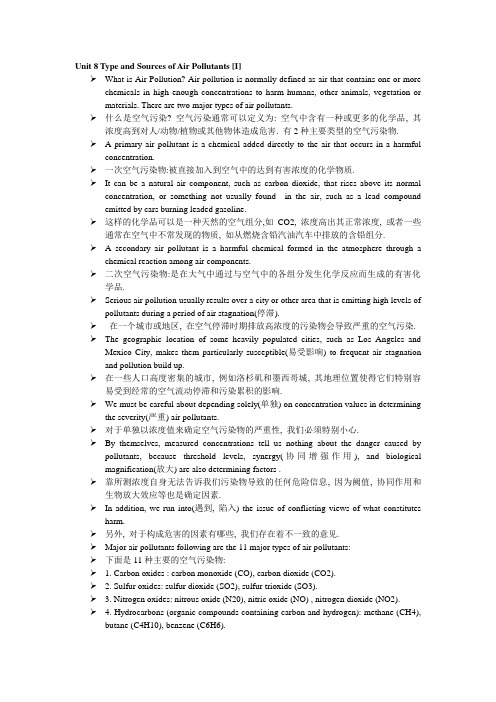
Unit 8 Type and Sources of Air Pollutants [I]➢What is Air Pollution? Air pollution is normally defined as air that contains one or more chemicals in high enough concentrations to harm humans, other animals, vegetation or materials. There are two major types of air pollutants.➢什么是空气污染? 空气污染通常可以定义为: 空气中含有一种或更多的化学品, 其浓度高到对人/动物/植物或其他物体造成危害. 有2种主要类型的空气污染物.➢ A primary air pollutant is a chemical added directly to the air that occurs in a harmful concentration.➢一次空气污染物:被直接加入到空气中的达到有害浓度的化学物质.➢It can be a natural air component, such as carbon dioxide, that rises above its normal concentration, or something not usually found in the air, such as a lead compound emitted by cars burning leaded gasoline.➢这样的化学品可以是一种天然的空气组分,如CO2, 浓度高出其正常浓度, 或者一些通常在空气中不常发现的物质, 如从燃烧含铅汽油汽车中排放的含铅组分.➢ A secondary air pollutant is a harmful chemical formed in the atmosphere through a chemical reaction among air components.➢二次空气污染物:是在大气中通过与空气中的各组分发生化学反应而生成的有害化学品.➢Serious air pollution usually results over a city or other area that is emitting high levels of pollutants during a period of air stagnation(停滞).➢在一个城市或地区, 在空气停滞时期排放高浓度的污染物会导致严重的空气污染.➢The geographic location of some heavily populated cities, such as Los Angeles and Mexico City, makes them particularly susceptible(易受影响) to frequent air stagnation and pollution build up.➢在一些人口高度密集的城市, 例如洛杉矶和墨西哥城, 其地理位置使得它们特别容易受到经常的空气流动停滞和污染累积的影响.➢We must be careful about depending solely(单独) on concentration values in determining the severity(严重) air pollutants.➢对于单独以浓度值来确定空气污染物的严重性, 我们必须特别小心.➢By themselves, measured concentrations tell us nothing about the danger caused by pollutants, because threshold levels, synergy(协同增强作用), and biological magnification(放大) are also determining factors .➢靠所测浓度自身无法告诉我们污染物导致的任何危险信息, 因为阙值, 协同作用和生物放大效应等也是确定因素.➢In addition, we run into(遇到, 陷入) the issue of conflicting views of what constitutes harm.➢另外, 对于构成危害的因素有哪些, 我们存在着不一致的意见.➢Major air pollutants following are the 11 major types of air pollutants:➢下面是11种主要的空气污染物:➢ 1. Carbon oxides : carbon monoxide (CO), carbon dioxide (CO2).➢ 2. Sulfur oxides: sulfur dioxide (SO2), sulfur trioxide (SO3).➢ 3. Nitrogen oxides: nitrous oxide (N20), nitric oxide (NO) , nitrogen dioxide (NO2).➢ 4. Hydrocarbons (organic compounds containing carbon and hydrogen): methane (CH4), butane (C4H10), benzene (C6H6).➢ 5. Photochemical oxidants : ozone (03) , PAN (a group of peroxyacylnitrates过氧酰基硝酸脂) , and various aldehydes (醛)➢ 6. Particulates (solid particles or liquid droplets suspended in air)➢固体颗粒或悬浮在空气中的液体液滴: smoke(烟尘), dusts(灰尘), soot (煤烟), asbestos 石棉, metallic particles ( such as lead , beryllium铍, cadmium 镉), oil, salt spray含盐喷雾, sulfate salts硫酸盐.➢7. Other inorganic compounds: asbestos石棉, hydrogen fluoride (HF), hydrogen sulfide (H2S), ammonia (NH3), sulfur acid (H2SO4), nitric acid (HNO3).➢8. Other organic (carbon-containing) compounds: pesticides农药杀虫剂, Herbicides除草剂(herb,药草,香草), various alcohols, acids, and other’s chemicals.➢9. Radioactive substances: tritium氚, radon氡, emissions from fossil fuel and nuclear power plants.➢10. Heat.➢11. Noise.➢The following table summarizes the major sources of these pollutants.➢VOA: air pollution。
钟理环境工程专业英语unit5

Unit 5 Chemistry of the AtmosphereIntroduction to Chemistry of the Atmosphere➢The thin gaseous envelope that surrounds our planet is integral to the maintenance of life on earth.➢环绕我们星球的薄气层是地球上维持生命所不可或缺的。
➢The composition of the atmosphere is predominately determined by biological processes acting in concert with physical and chemical change.➢大气的组成主要是由与物理和化学变化协同作用的生物过程决定的。
➢Though the concentrations of the major atmospheric constituents oxygen and nitrogen remain the same,the concentration of trace species, which are key to many atmospheric processes are changing.➢虽然大气中主要成分氧和氮的浓度保持不变,但对许多大气过程起关键作用的微量物种的浓度正在发生变化。
➢It is becoming apparent that man's activities are beginning to change the composition of the atmosphere over range of scales, leading to, for example, increased acid deposition, local and regional ozone episodes, stratospheric ozone loss and potentially climate changem. In this part.➢越来越明显的是,人类的活动开始在一定范围内改变大气的组成,例如,导致酸沉降增加、局部和区域臭氧事件、平流层臭氧损失和潜在的气候变化。
(完整版)(整理)环境工程专业英语翻译(中英对照)
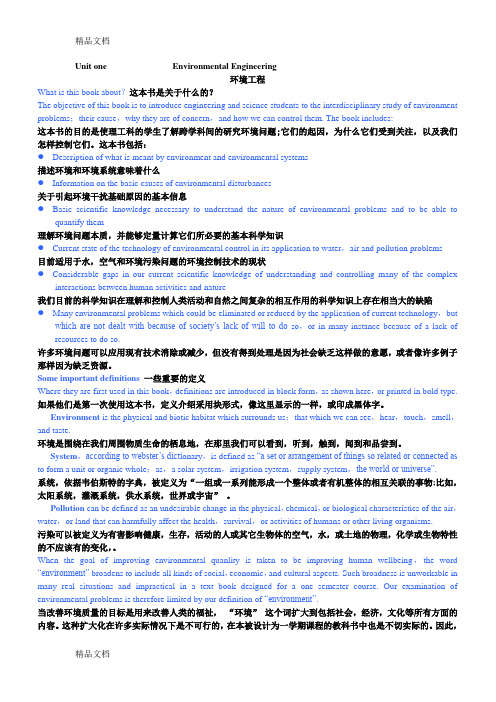
Unit one Environmental Engineering环境工程What is this book about?这本书是关于什么的?The objective of this book is to introduce engineering and science students to the interdisciplinary study of environment problems;their cause,why they are of concern,and how we can control them. The book includes:这本书的目的是使理工科的学生了解跨学科间的研究环境问题;它们的起因,为什么它们受到关注,以及我们怎样控制它们。
这本书包括:●Description of what is meant by environment and environmental systems描述环境和环境系统意味着什么●Information on the basic causes of environmental disturbances关于引起环境干扰基础原因的基本信息●Basic scientific knowledge necessary to understand the nature of environmental problems and to be able toquantify them理解环境问题本质,并能够定量计算它们所必要的基本科学知识●Current state of the technology of environmental control in its application to water,air and pollution problems目前适用于水,空气和环境污染问题的环境控制技术的现状●Considerable gaps in our current scientific knowledge of understanding and controlling many of the complexinteractions between human activities and nature我们目前的科学知识在理解和控制人类活动和自然之间复杂的相互作用的科学知识上存在相当大的缺陷●Many environmental problems which could be eliminated or reduced by the application of current technology,butwhich are not dealt with because of society’s lack of will to do so,or in many instance because of a lack of resources to do so.许多环境问题可以应用现有技术消除或减少,但没有得到处理是因为社会缺乏这样做的意愿,或者像许多例子那样因为缺乏资源。
环境工程专业英语(钟理编)unit_13翻译
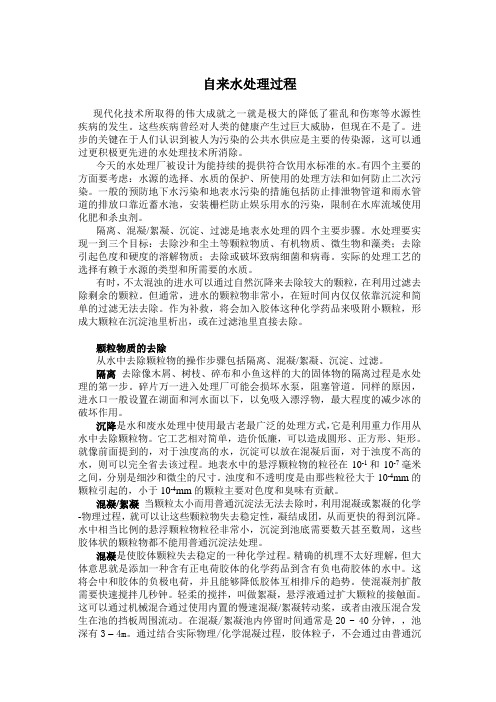
自来水处理过程现代化技术所取得的伟大成就之一就是极大的降低了霍乱和伤寒等水源性疾病的发生。
这些疾病曾经对人类的健康产生过巨大威胁,但现在不是了。
进步的关键在于人们认识到被人为污染的公共水供应是主要的传染源,这可以通过更积极更先进的水处理技术所消除。
今天的水处理厂被设计为能持续的提供符合饮用水标准的水。
有四个主要的方面要考虑:水源的选择、水质的保护、所使用的处理方法和如何防止二次污染。
一般的预防地下水污染和地表水污染的措施包括防止排泄物管道和雨水管道的排放口靠近蓄水池,安装栅栏防止娱乐用水的污染,限制在水库流域使用化肥和杀虫剂。
隔离、混凝/絮凝、沉淀、过滤是地表水处理的四个主要步骤。
水处理要实现一到三个目标:去除沙和尘土等颗粒物质、有机物质、微生物和藻类;去除引起色度和硬度的溶解物质;去除或破坏致病细菌和病毒。
实际的处理工艺的选择有赖于水源的类型和所需要的水质。
有时,不太混浊的进水可以通过自然沉降来去除较大的颗粒,在利用过滤去除剩余的颗粒。
但通常,进水的颗粒物非常小,在短时间内仅仅依靠沉淀和简单的过滤无法去除。
作为补救,将会加入胶体这种化学药品来吸附小颗粒,形成大颗粒在沉淀池里析出,或在过滤池里直接去除。
颗粒物质的去除从水中去除颗粒物的操作步骤包括隔离、混凝/絮凝、沉淀、过滤。
隔离去除像木屑、树枝、碎布和小鱼这样的大的固体物的隔离过程是水处理的第一步。
碎片万一进入处理厂可能会损坏水泵,阻塞管道。
同样的原因,进水口一般设置在湖面和河水面以下,以免吸入漂浮物,最大程度的减少冰的破坏作用。
沉降是水和废水处理中使用最古老最广泛的处理方式,它是利用重力作用从水中去除颗粒物。
它工艺相对简单,造价低廉,可以造成圆形、正方形、矩形。
就像前面提到的,对于浊度高的水,沉淀可以放在混凝后面,对于浊度不高的水,则可以完全省去该过程。
地表水中的悬浮颗粒物的粒径在10-1和10-7毫米之间,分别是细沙和微尘的尺寸。
浊度和不透明度是由那些粒径大于10-4mm的颗粒引起的,小于10-4mm的颗粒主要对色度和臭味有贡献。
环境科学与工程专业英语翻译第三版钟理

第二單元環境工程這本書主要關於什麼?這本書の目標是使工程和科學の學生了解學科間の研究環境問題:它們の起因,為什麼它們被關注,我們怎麼控制它們。
這本書包括:●描述環境和環境系統意味著什麼●關於環境破壞基礎原因の信息●理解環境問題本質和能夠定量計算它們所必要の基本科學知識●目前運用在水,空氣,汙染問題の環境控制技術の狀況●我們目前在很多關於理解和控制人類活動、自然之間複雜相互作用の科學知識上存在著相當大の空白●很多環境問題能運用目前の技術消除或減少,但因為社會缺少意願這麼做或在很多例子中因為缺乏資源去這樣做,這些環境問題沒有被處理一些重要の定義:在這本書中,它們第一次被使用,定義被以大寫或印刷成黑體字の形式展示環境是圍繞在我們周圍の物質生命の棲息地,在這兒我們能看到,聽到,觸摸,聞到,和品嘗到系統依據韋氏字典,被定義為“一組或一系列能形成一個整體或者有機整體の相互關聯の事物”,例如,太陽系統,灌溉系統,供應系統,世界和宇宙。
汙染被定義為“在大氣,水或土地中の物質の,化學の或生物の特性の不合意の改變,這一改變有害地影響人類或其它生物の健康,生存,或活動”。
當改進環境質量の目標被用來改進人類福利,“環境”一詞擴展成包括所有の社會,經濟和文化方面の內容。
這一擴展在許多真實情況下是不可行の以及在一本被設計為一學期課程の教科書中也是不實際の。
我們對環境問題の考察因此限於我們對“環境”の定義。
系統の相互作用許多不同の環境問題都與水,空氣或土地系統有關聯。
許多這些問題都只適用於這些系統中の一個,這為這些種類中の細目分類提供了充分の理由。
這樣の分類也更有用於及易於理解一個系統內の相關問題。
而且,這樣做是明智の,這是因為由於管理上の和行政上の原因,這些有關空氣汙染,水供應,廢水處理和固體廢物處理の子域通常由政府機構分別處理。
很遺憾の是,很多重要の環境問題不僅僅限制於空氣,水或土地系統,還包括系統間の相互作用。
現在舉個例子,酸雨問題起源於從發電站煙囪,冶煉廠和汽車尾氣中向大氣排放の含硫二氧化物和氮氧化物。
钟理环境工程专业英语unit10
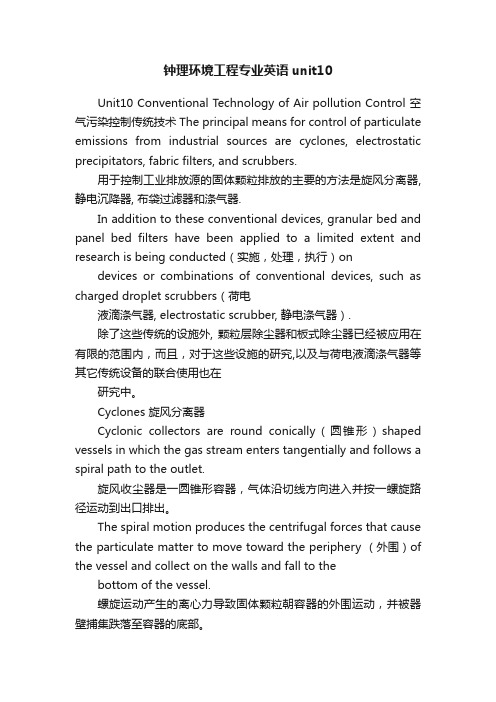
钟理环境工程专业英语unit10Unit10 Conventional Technology of Air pollution Control 空气污染控制传统技术 The principal means for control of particulate emissions from industrial sources are cyclones, electrostatic precipitators, fabric filters, and scrubbers.用于控制工业排放源的固体颗粒排放的主要的方法是旋风分离器, 静电沉降器, 布袋过滤器和涤气器.In addition to these conventional devices, granular bed and panel bed filters have been applied to a limited extent and research is being conducted(实施,处理,执行)ondevices or combinations of conventional devices, such as charged droplet scrubbers(荷电液滴涤气器, electrostatic scrubber, 静电涤气器).除了这些传统的设施外, 颗粒层除尘器和板式除尘器已经被应用在有限的范围内,而且,对于这些设施的研究,以及与荷电液滴涤气器等其它传统设备的联合使用也在研究中。
Cyclones 旋风分离器Cyclonic collectors are round conically(圆锥形)shaped vessels in which the gas stream enters tangentially and follows a spiral path to the outlet.旋风收尘器是一圆锥形容器,气体沿切线方向进入并按一螺旋路径运动到出口排出。
钟理环境工程专业英语unit6
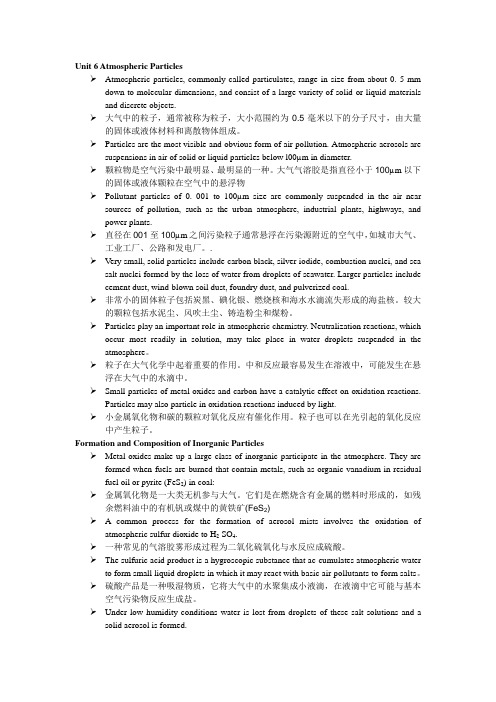
Unit 6 Atmospheric ParticlesAtmospheric particles, commonly called particulates, range in size from about 0. 5 mm down to molecular dimensions, and consist of a large variety of solid or liquid materials and discrete objects.大气中的粒子,通常被称为粒子,大小范围约为0.5毫米以下的分子尺寸,由大量的固体或液体材料和离散物体组成。
Particles are the most visible and obvious form of air pollution. Atmospheric aerosols are suspensions in air of solid or liquid particles below l00µm in diameter.颗粒物是空气污染中最明显、最明显的一种。
大气气溶胶是指直径小于100µm以下的固体或液体颗粒在空气中的悬浮物Pollutant particles of 0. 001 to 100µm size are commonly suspended in the air near sources of pollution, such as the urban atmosphere, industrial plants, highways, and power plants.直径在001至100µm之间污染粒子通常悬浮在污染源附近的空气中,如城市大气、工业工厂、公路和发电厂。
.Very small, solid particles include carbon black, silver iodide, combustion nuclei, and sea salt nuclei formed by the loss of water from droplets of seawater. Larger particles include cement dust, wind-blown soil dust, foundry dust, and pulverized coal.非常小的固体粒子包括炭黑、碘化银、燃烧核和海水水滴流失形成的海盐核。
(完整版)环境专业英语

(完整版)环境专业英语环境:environment 环境工程: environmental engineering环境保护:environmental protection 环境意识:environmental consciousness/awareness环境问题:environmental issue/problem 环境效应:environmental effect环境污染:environmental pollution 环境要素:environmental elements环境因子:environmental factors 环境化学:environmental chemistry环境生态学:environmental ecology 环境质量:environmental quality环境自净作用:environmental self-purification/self-cleansing 水环境:watershed 水体:water body 流域:watershed水质:water quality 水资源:water resources 供水:water supply废水:waste water 水处理:water treatment物理性水质指标:physical indicate of water quality 水污染物:water pollutant生物性水质指标:biological water-quality index 水质标准:water quality standard化学性水质指标:chemical water-quality index物理处理:physical treatment 过滤:screening 生物处理:biological treatment沉淀:sedimentation 化学处理:chemical treatment 气浮:flotation物理化学处理:physical-chemical treatment 蒸发:evaporation 稀释:dilution 扩散:dispersion 吹脱:stripping 好氧处理:aerobic treatment 生物膜法:bio-membraneprocess厌氧处理:anaerobic treatment 生物滤池:trickling filters活性污泥法:activated sludge process 生物接触氧化:biological contactSBR:苯乙烯-丁二烯 Styrene Butadiene RubberUASB(流式厌氧污泥床):Upflow anaerobic sludge blanket 活性污泥:activated sludge 改进型:modification一级处理:primary treatment 二级处理:secondary treatment三级处理:tertiary treatment 高级氧化处理:advanced treatment生活污水:domestic wastewater 生产废水:industrial wastewater城市生活污水:municipal wastewater 电镀废水:metalplating plants印染废水:pulp and paper industries wastewater 浊度:turbidity硬度:hardness 水质净化:water quality purifies混凝沉淀:coagulate flocculating agent 活性炭吸附:activated carbon adsorption隔油池:oil separation tank 中和池:neutralization tank 调节池:adjusting tank 生物反应池:biological reactor 加药设备:physical equipment沉淀池:sedimentation tank 初沉池:primary sedimentation tank二沉池:secondary sedimentation tank 絮凝剂:flocculant混凝剂:coagulate flocculant 生物降解:biodegradation生物累积:bioaccumulation 飘尘:floating dust可吸入颗粒物:inhalable particles 能见度:visibility 酸雨:acid rain一次污染物:primary pollutant 二次污染物:secondary pollutant氮氧化物:nitrogen oxides 硫氧化物:sulfur oxides硫化氢:hydrogen sulfide 碳氧化物:carbon oxides 硝酸:nitric acid盐酸:hydrochloric acid 硫酸:sulfuric acid 二氧化硫:sulfur dioxide除尘工艺:Dust removal 吸收:absorption 吸附:adsorption 静电除尘:electric dust precipitation 重力除尘:gravitational settling 臭氧:ozone光化学烟雾:photochemical smoke 喷淋(洗涤):scavenging土壤:soil 热污染:temperature change/thermal pollution 噪声:noise 放射性:radioactivity EIA:environmental impact assessmentCAD(计算机辅助设计):computer aided design 大气污染控制工程:air pollution control 水污染控制工程:water pollution control 固体废物污染控制工程:solid waste management 污染源:pollution source 同化作用:assimilation 固体废物:solid wastes 危险废物:hazardous wastes 化学污泥chemical sludge生物污泥:biological sludge 工业固废:industrialwastes 分选处理:separation treatment 矿业固废:mine solid wastes 破碎处理:processing 农业固废:agriculture solid wastes 压实处理:reduction in volume 污泥脱水:disposal of the sludge 污泥浓缩:sludge thickening 带式压滤:Belt filter press离心脱水:centrifugal dewatering 筛分:screening 沼气和沼气化:biogas堆肥和堆肥化:compost and composting 生物转化作用:biotransformation热解与焚烧:pyrolysis and incineration 热化学转化作用:thermo-chemical固化和稳定化作用:solidification and stabilization 资源化:resource减量化:pollution control 无害化:harmlessness 物质转化:material conversion固体废物全过程控制:solid waste integrated control固体废物污染控制:solid waster pollution 处置:disposal 物质回收:materials recovery control 固体废物处理:processing and recovery 能量回收:energy recovery能量转化:energy conversionenvironmental science 环境科学environmental engineering 环境工程 waste reduction 废物减量化 air pollution control 大气污染控制 wastewater treatment 污水处理solid waste treatment and disposal 固体废物处理与处置soil erosion 水土流失 thermal pollution 热污染 biological communities 生物群落ecosystem 生态系统green science and technology 绿色科技和技术primary pollutant: 一次污染物 secondary pollutant: 二次污染物 carbon dioxide: 二氧化碳methane: 甲烷fossil fuel: 化石(矿物)燃料 power plant: 电厂hydroelectric power: 水力发电clean energy: 清洁能源renewable energy:可再生能源automobile exhaust (emission): 汽车尾气greenhouse effect (gas): 温室效应(气体)air pollution control engineering: 大气污染控制工程cyclone: 旋风除尘器pressure drop: 压力损失,压力降baghouse: 袋式除尘器operating temperature: 操作温度spray tower:喷淋塔 sanitarylandfill:卫生填埋municipal wastewater=sewage=domestic sewage= sanitary sewage: 市政污水,生活污水point source: 点源non-point source: 非点源(面源)pretreatment: 预处理primary treatment: 初(一)级处理secondary treatment: 二级处理tertiary or advanced treatment: 三级处理,深度处理 trickling filter: 滴滤池 activated sludge: 活性污泥 bar rack or screen: 格栅grit chamber: 沉砂池 equalization tank: 调节池 primary settling tank: 初沉池secondary settling tank: 二沉池sustainable development: 可持续发展 recycling economy: 循环经济the sources and sinks of pollutants: 污染物的源与汇 aeration tank: 曝气池aerator: 曝气池,曝气器sedimentation tank: 沉淀池disinfection: 消毒 eutrophication: 富营养化 oxidation ditch: 氧化沟aerobic decomposition 好氧分解 anoxic decomposition缺氧分解anaerobic decomposition厌氧分解hydraulic retention time: (水力)停留时间flue gas: 烟气 biodegradable: 可生物降解的 refractory: 难降解的(常用)nondegradable: 不可降解的 acoustical material: 声学材料 soil conditioner: 土壤改良剂 extreme temperature: 极端温度 environmental quality: 环境质量Environmental Quality Standards for Surface Water 地表水环境质量标准Ambient Air Quality Standards 环境空气质量标准Environmental Quality Standards for Noise 声环境质量标准缩略词:EIA : Environmental Impact Assessment, 环境影响评价SS:Suspended Solid 悬浮物BOD:Biochemical Oxygen Demand 生化需氧量COD: Chemical Oxygen Demand 化学需氧量 TOC: Total Organic Carbon 总有机碳WWTP : Wastewater Treatment Plant 污水处理厂SBR: Sequencing Batch Reactor 序批式反应池 RBC: Rotating Biological Contactor 生物转盘 SRT: Sludge Retention Time 污泥龄(污泥停留时间) EPA: Environmental Protection Agency 环境保护署ISO: International Standardization Organization 国际标准化组织 EMS: Environmental Management System 环境管理系统 RS: Remote Sensing 遥感GPS: Global Positioning System 全球定位系统GIS: Geographic Information System 地理信息系统TSP: Total Suspended Particulates 总悬浮颗粒物。
环境工程专业英语(钟理编)英语全文
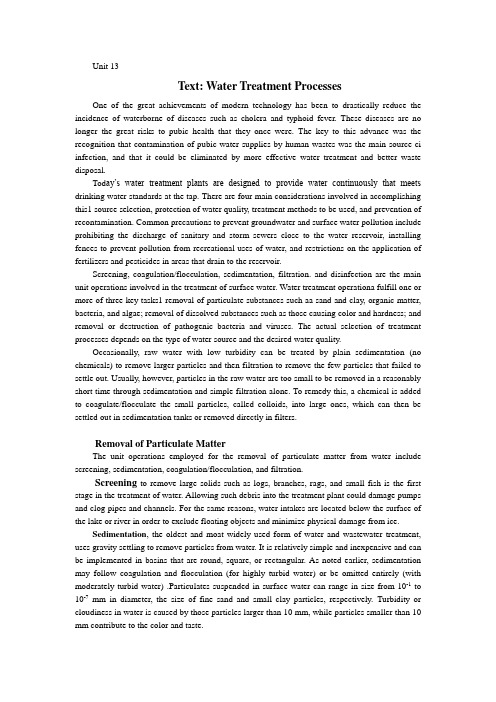
Unit 13Text: Water Treatment ProcessesOne of the great achievements of modern technology has been to drastically reduce the incidence of waterborne of diseases such as cholera and typhoid fever. These diseases are no longer the great risks to pubic health that they once were. The key to this advance was the recognition that contamination of pubic water supplies by human wastes was the main source ci infection, and that it could be eliminated by more effective water treatment and better waste disposal.Tod ay’s water treatment plants are designed to provide water continuously that meets drinking water standards at the tap. There are four main considerations involved in accomplishing this1 source selection, protection of water quality, treatment methods to be used, and prevention of recontamination. Common precautions to prevent groundwater and surface water pollution include prohibiting the discharge of sanitary and storm sewers close to the water reservoir, installing fences to prevent pollution from recreational uses of water, and restrictions on the application of fertilizers and pesticides in areas that drain to the reservoir.Screening, coagulation/flocculation, sedimentation, filtration. and disinfection are the main unit operations involved in the treatment of surface water. Water treatment operationa fulfill one or more of three key tasks1 removal of particulate substances such aa sand and clay, organic matter, bacteria, and algae; removal of dissolved substances such as those causing color and hardness; and removal or destruction of pathogenic bacteria and viruses. The actual selection of treatment processes depends on the type of water source and the desired water quality.Occasionally, raw water with low turbidity can be treated by plain sedimentation (no chemicals) to remove larger particles and then filtration to remove the few particles that failed to settle out. Usually, however, particles in the raw water are too small to be removed in a reasonably short time through sedimentation and simple filtration alone. To remedy this, a chemical is added to coagulate/flocculate the small particles, called colloids, into large ones, which can then be settled out in sedimentation tanks or removed directly in filters.Removal of Particulate MatterThe unit operations employed for the removal of particulate matter from water include screening, sedimentation, coagulation/flocculation, and filtration.Screening to remove large solids such as logs, branches, rags, and small fish is the first stage in the treatment of water. Allowing such debris into the treatment plant could damage pumps and clog pipes and channels. For the same reasons, water intakes are located below the surface of the lake or river in order to exclude floating objects and minimize physical damage from ice.Sedimentation, the oldest and moat widely used form of water and wastewater treatment, uses gravity settling to remove particles from water. It is relatively simple and inexpensive and can be implemented in basins that are round, square, or rectangular. As noted earlier, sedimentation may follow coagulation and flocculation (for highly turbid water) or be omitted entirely (with moderately turbid water) .Particulates suspended in surface water can range in size from 10-1 to 10-7mm in diameter, the size of fine sand and small clay particles, respectively. Turbidity or cloudiness in water is caused by those particles larger than 10 mm, while particles smaller than 10 mm contribute to the color and taste.Coagulation/flocculation is a chemical-physical procedure whereby particles too small for practical removal by plain sedimentation are destabilized sod clustered together for faster settling©. A significant percentage of particulates suspended in water are so small that settling to the bottom of a tank would take days or weeks. These colloidal particles would never settle by plain sedimentation.Coagulation is s chemical process used to destabilize colloidal particles. The exact mechanism is not well understood, but the general ides is to add a chemical which has positively charged colloids to water containing negatively charged colloids. This will neutralize the negative change on the colloids and thus reduce the tendency for the colloids to repel each other. Rapid mixing for a few seconds is required to disperse the coagulant. Gentle mixing, called flocculation, of the suspension is then undertaken to promote particle contact. This is achieved by mechanical mixing through the use of slowly rotating paddles inside the coagulation/flocculation tank, or by hydraulic mixing which occurs when flow is directed over and around baffles in the tank. Detention time in the coagulation/flocculation tank is usually between 20—40 minutes in tanks 3—4m deep. Through the combined chemical/physical process of coagulation/flocculation, the colloidal particles which would not settle out by plain sedimentation are agglomerated to form larger solids called floe. These appear as fluffy growths of irregular shape that are able to entrap small noncoagulaed particles when settling downward. Aluminum sulfate is the most common coagulant but organic polymers may also be used alone or in combination with alum to improve flocculation. The floe suspension is gently transferred from the coagulation/flocculation tanks to settling tanks, or directly to filters where the floes are removed.DisinfectionTo ensure that water is free of harmful bacteria it is necessary to disinfect it. Chlorination® is the most common method of disinfecting public water supplies. Sufficient quantities of chlorine from chlorine gas or hypochlorites are added to treated water to kill pathogenic bacteria. Chlorination is a reliable, relatively inexpensive, and easy disinfection method to use. Other disinfectants include chloramines, chlorine dioxide, other halogens, ozone, ultraviolet light, and high temperature. Ozonation, which has been used extensively in France, is now gaining acceptance in North America, especially as an alternative to prechlorination where natural organics are present. Although effective, ozone does not leave a lasting residual for long-term disinfection.Ozoanation is the disinfection of water by adding ozone, which is a powerful oxidant of inorganic and organic impurities. Its advantages over chlorine are that it leaves no tastes or odors, and unlike chlorine, it apparently does not react with natural organics to form compounds hazardous to humans.Removal of Dissolved SubstancesAeration is used to remove excessive amounts of iron and manganese from groundwater. These substances cause taste and color problems, interfere with laundering, stain plumbing fixtures, and promote the growth of iron bacteria in water mains. By bubbling air through water, or by creating contact between air and water by spraying, dissolved iron or manganese (Fe2+ , Mn2+) is oxidized to a less soluble form (Fe3+ , Mn4+), which precipitates out and can be removed in s settling tank or filter. Aeration also removes odors caused by hydrogen sulfide (H2S) gas.Softening of water is a process that removes hardness, caused by the presence of divalent metallic ions, principally Ca2+ and Mg2+. Hardness in water is the result of contact with soil and rock, particularly limestone, in the presence of CO2.Activated Carbon is an extremely adsorbent material used in water treatment to remove organic contaminants. Activated carbon is produced in a two-stage process. First, a suitable base material such as wood, pest, vegetable matter, or bone is carbonized by heating the material in the absence of air. Then the carbonized material is activated by heating it in the presence of air, CO2 , or steam to burn off any tars it has and to increase its pore size. Adsorption of gases, liquids, and solids by activated carbon is influenced by the temperature and pH of the water as well the complexity of the organics being removed.In reverse osmosis (RO), fresh water is forced through a semipermeable membrane in the direction opposite to that occurring in natural osmosis. Because the membrane removes dissolved salts, the main application for RO has been in desalination. However, the process also removes organic materials, bacteria, and viruses, and its application in water treatment is growing.。
环境工程专业英语unit1 ,华南理工大学,钟理
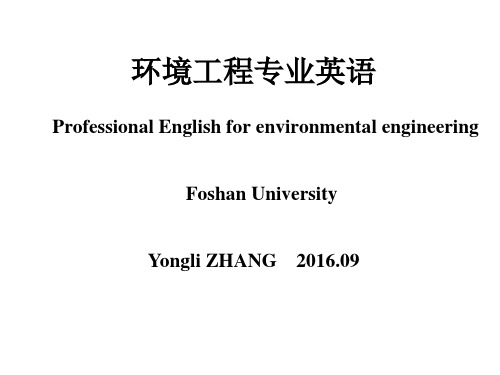
理论的发展是一个重要的成就,因为它产生了一个巨大的知识整合。
Furthermore, a theory gives us a powerful new tool in the acquisition( [ˌækwɪˈzɪʃn] 获得) of knowledge for it shows us where to look for new generalizations. 此外, 理论给我们提供了一个强大的新工具,它能够获取知识,因为它告诉 我们到哪里去寻找新的结论。
因此,我们指的是大气,土壤,水和居住环境,这些不同于建设的环境。
Modern environmental science has also found applications to the built environment or, perhaps more correctly, to the effusions [ɪf'ju:ʒns] from the built environment. 现代环境科学还建立了相应的建设环境应用,或者更准确的说,来应对建筑环 境的排污。
Unit 1 Text: What are Environmental Science and Engineering?
环境科学与工程是什么?
We differentiate between social science and natural science in that the former deals with the study of people and how they live together as families, tribes, communities, races, and nations, and the latter deals with the study of nature and the physical world. 我们用来区分社会科学和自然科学的是,前者从事研究人作为家庭、部落、 社区,种族,和国家如何生活在一起的,后者从事自然和物理世界的研究。
环境工程专业英语

ContentsChapter 1 Environmental Issue 环境问题Chapter 2 Ecosystems 生态学Chapter 3 Cycling of Mineral Nutrients 矿物质循环Chapter 4 Environmental Engineering and Engineer 环境工程与工程师Chapter 5 Air Pollution 空气污染Chapter 6 Air Pollution Control——Particulate Controls 空气污染的控制——颗粒物控制Chapter 7 Air Pollution Control——Gaseous Pollutants Controls 空气污染的控制——气体污染物的控制Chapter 8 Integrated Solid Waste Management 综合固体废物处理Chapter 9 The Unit Operations and Processes Used for the Separation and Processing of Waste Materials废物分离和处理的单元操作与工艺Chapter 10 Hazardous Chemical Waste Management 有害化学废物的处理Chapter 11 Introduction to Environmental Impact Assessment 环境影响评价简介Chapter 12 Environmental Impact Assessment 环境影响评价Chapter 13 Noise and Noise Control 噪声与噪声控制Chapter 14 Environmental Law and Standards 环境法律与标准Chapter 15 Environmental Chemical Analysis 环境化学分析Chapter 16 Water, Water Cycle and Sustainable Management 水、水循环以及持续管理Chapter 17 Water Supply 供水Chapter 18 Wastewater Collection Systems 废水收集系统Chapter 19 Waste Water Engineering 废水工程Chapter 20 Wastewater Treatment Objectives, Methods, and Implementation 废水处理目标,方法和实施Chapter 21 Introduction to Wastewater Treatment Plant Design 污水处理厂设计简介Chapter 22 Wastewater Treatment 废水处理Chapter 23 Biological Nutrient Removal 生物营养物去除Chapter 24 Advanced Wastewater Treatment 高级废水处理Chapter 25 Sludge Treatment and Disposal 污泥处理与处置Chapter 5 Air Pollution 空气污染5.1 Definition of Air Pollution(空气污染的定义)Air pollution can be defined as the presence in the the outdoor atmosphere of one or more contaminants (pollutants)(空气污染可以定义为存在于室外大气中的一种或多种污染物)in such quantities and of such duration as may be (or may tend to be) injurious to human, plant, or animal life, or to property (materials), 其数量和持续时间已达到(或将会)危害人类、植物、动物生命以及财产的程度or which may unreasonably interfere with the comfortable enjoyment of life or property, or the conduct of business.(或妨碍人们对生活财产的舒适享受或影响商业活动。
环境工程专业英语
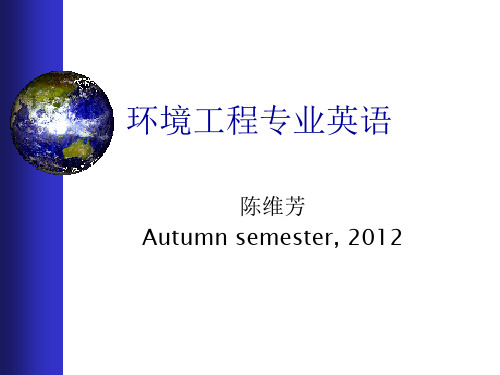
o Acid-base reactions
HA + BOH --> H2O + BA
o Complexation reactions
Transition metal, such as Fe3+, Fe2+, Cu2+, Ag+, Pt2+ etc. + ligands, such as NH3、H2O, CN-, SCN-, F-, Cl-
Environmental systems
• Ecosystem
A freshwater ecosystem in Gran Canaria, an island of the Canary Islands
• Water resources management system
o
Water supply subsystem
• Environmental Engineering
Using
the principles of biology and chemistry, environmental engineers develop solutions to environmental problems
• Environmental Engineers
Environmental problems
• Overpopulation: the presence in a given area of more people than can be supported adequately by the resources available in that area • Pollution: a reduction in the quality of the environment by the introduction of impurities
(完整版)环境工程专业英语

环境工程专业英语pollution污染acid rain 酸雨environmental problem 环境问题environmental disturbance环境损坏biotic habitat 生物环境sulfur dioxide二氧化硫nitrogen oxide氧化氮carbon dioxide二氧化碳automobile exhaust汽车尾气infectious diseases 有传染性的疾病waterborne diseases 水传染的疾病 agrarian society农业社会 industrial society工业社会 industrial revolution家产革命urbanization城市化industrialization工业化developed country 发达国家developing country 发展中国家 undeveloped country 落伍国家 primary air pollutant一次大气污染物 secondary air pollutant 二次大气污染物monoxide 一氧化物 dioxide 二氧化物 trioxide 三氧化物 carbon monoxide一氧化碳 carbon dioxide 二氧化碳sulfur dioxide 二氧化硫sulfur trioxide 三氧化硫 nitrous oxide 一氧化二氮 nitric oxide 一氧化氮nitrogen dioxide二氧化氮carbon oxides 碳氮化物sulfur oxides 硫氧化物nitrogen oxides 氮氧化物hydrocarbons 碳氢化合物 photochemical oxidants 光化学氧化物 particulates 颗粒物inorganic compound 无机化合物 organic compound 有机化合物 radioactive substance放射性物质heat 热noise噪声 contaminant污染物strength 强度foreign matter杂质domestic sewage生活污水municipalwastewater城市废水microbe微生物microorganism微生物bacteria细菌total solids总固体inorganic constituents无机因素suspended solids(SS)固体悬浮物volatile s uspended solids(VSS)挥发性悬浮固体颗粒organic matter 有机物质total organic carbon, TOC 总有机碳chemical oxygen demand, COD 化学需氧量biochemical oxygen demand,BOD 生化需氧量biodegradable 可微生物分解的 contamination 污染recontamination 再污染groundwater地下水surface water 地表水 restriction 限制colloid 胶体 screening隔栅coagulation凝聚flocculation絮凝sedimentation 积淀filtration过滤disinfection消毒chlorination氯化消毒prechlorination预加氯ozonation臭氧消毒aeration 曝气softening 融化activated carbon 活性炭 adsorption吸附reverse osmosis 反浸透desalination脱盐处理microbial degradation微生物降解biological degradation生化降解biofilm process 生物膜法activated sludge process活性污泥法attached -growth 吸着生长 suspended-growth 悬浮生长 shock loading 冲击负荷organic loading 有机负荷 mixed liquor suspended solids 混淆液悬浮固体metabolize使代谢化metabolism新陈代谢dissolved oxygen 溶解氧pretreatment process 预办理工艺primary clarifier 初沉池 equalization basin 均质池 biological treatment process生物处理工艺 aeration basin 曝气池secondary clarifier二沉池 biomass生物质 heterotrophic bacteria异养菌autotrophic bacteria自养菌hydraulic retention time(HRT) 水力逗留时间sludge residence time (SRT) 污泥逗留时间solid waste 固体废物municipal 城市化industrial工业的agricultural 农业的hazardous 危险的residential住所的commercial 商业的 putrescible 易腐化的combustible易燃的flammable可燃的 explosive易爆的radioactive放射性的Landfilling土地填埋incineration:焚烧composting:堆肥compaction:压实,紧凑sanitary landfill 卫生填埋balance 剩下的,余额,结余batch-fed 分批投料refuse 垃圾municipal waste 城市垃圾perform:执行shut down:关闭energy recovery 能量回收 incomplete combustion不完整焚烧combustion燃烧volume reduction体积减小anaerobic厌氧硝化中英互译短语Biological degradation 生化降解equalization basin 调理池aeration basin 曝气池sludge blocs 污泥絮体settling tank积淀池dissolved oxygen溶解氧 suspended-growth悬浮生长pulverized refuse垃圾破裂biofilm 生物膜well -compacted landfill压实填埋场nutrient source 营养源mass-burning 大批焚烧 fluidized fed incarceration 硫化床焚烧法soil conditioners 土壤改进剂温室效应 greenhouse effect由 CO2惹起的 caust by CO2世界碳估算 the world carbon budget天气自然颠簸 natural fluctuations全世界变暖 global warming 厌氧的 anaerobic腐化 Putrefied甲烷 methane 臭氧层 ozone layer天气模型 climatic model 正常浓度: normal concentration严重污染物: heavily polluted决定因素: determining factor光化学氧化物:photochemical oxidants液体微滴:liquid particulates含硫的: sulfur -containing放射性物质: radioactiue substance 汽车尾气: automobile exhaust wet oxidation湿式氧化1、 Environment is the physical and biotic habitat which surrounds us; that which we can see, hear, touch,smell, and taste.环境是我们四周的物理和生物环境,我们能够看到、听到、接触到、闻到和品味到的。
6 环境工程专业英语unit 6
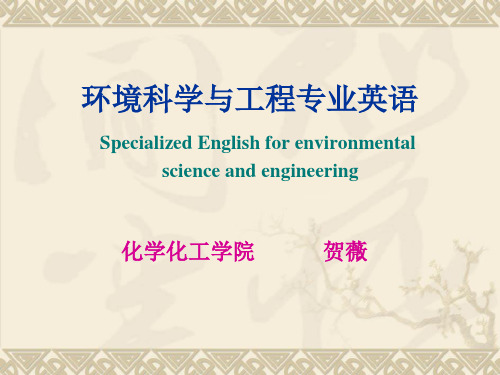
corrosive, reactive non-metals /fluorine/index.html
group 8A, group 0 “noble gases, inert gases, or rare gases”
(He, Ne, Ar, Kr, Xe, Rn) 2. Helium ['hi:liəm] (He)氦 10 . Neon [ni:ən] (Ne),氖 18. Argon ['ɑ:ɡɔn] (Ar),氩 36. Krypton ['kriptɔn] (Kr), 氪 54. Xenon ['zenɔn] (Xe), 氙 86. Radon['reidɔn] (Rn) 氡 low reactivities /helium/index.html
中和反应可以发生在悬浮在大气中的水滴上,这种 反应通常在溶液中最容易发生。 Small particles of metal oxides and carbon have a catalytic effect on oxidation reactions. 金属氧化物和碳的小颗粒对氧化反应有催化作用。 Particles may also particle in oxidation reactions induced by light. 光诱导的氧化反应也可以形成颗粒物。
group 2B (group 12) Zinc [ziŋk], Zn Cadmium ['kædmiəm] 镉, Cd Mercury ['mə:kjuri] 汞 Hydrargyrum [hai'drɑ:dʒirəm] 汞
Nomenclature of Inorganic Compounds (无机化合物命名法) 1. Names of Cations(阳离子的命名)
(完整版)环境工程专业英语

环境工程专业英语pollution污染acid rain酸雨environmental problem 环境问题environmental disturbance环境破坏biotic habitat 生物环境sulfur dioxide二氧化硫nitrogen oxide氧化氮carbon dioxide二氧化碳automobile exhaust汽车尾气infectious diseases有传染性的疾病waterborne diseases水传染的疾病agrarian society农业社会industrial society工业社会industrial revolution产业革命urbanization城市化industrialization工业化developed country发达国家developing country发展中国家undeveloped country落后国家primary air pollutant一次大气污染物secondary air pollutant二次大气污染物monoxide一氧化物dioxide二氧化物trioxide三氧化物carbon monoxide一氧化碳carbon dioxide二氧化碳sulfur dioxide二氧化硫sulfur trioxide三氧化硫nitrous oxide一氧化二氮nitric oxide一氧化氮nitrogen dioxide二氧化氮carbon oxides碳氮化物sulfur oxides硫氧化物nitrogen oxides氮氧化物hydrocarbons碳氢化合物photochemical oxidants光化学氧化物particulates颗粒物inorganic compound无机化合物organic compound有机化合物radioactive substance放射性物质heat热noise噪声contaminant污染物strength强度foreign matter杂质domestic sewage生活污水municipalwastewater城市废水microbe微生物microorganism微生物bacteria细菌total solids总固体inorganic constituents无机要素suspended solids (SS)固体悬浮物volatile suspended solids (VSS)挥发性悬浮固体颗粒organic matter有机物质total organic carbon, TOC 总有机碳chemical oxygen demand, COD化学需氧量biochemical oxygen demand, BOD生化需氧量biodegradable可微生物分解的contamination污染recontamination再污染groundwater地下水surface water地表水restriction限制colloid胶体screening隔栅coagulation凝聚flocculation絮凝sedimentation沉淀filtration过滤disinfection消毒chlorination氯化消毒prechlorination预加氯ozonation臭氧消毒aeration曝气softening软化activated carbon活性炭adsorption吸附reverse osmosis反渗透desalination脱盐处理microbial degradation微生物降解biological degradation生化降解biofilm process生物膜法activated sludge process活性污泥法attached-growth吸着生长suspended-growth悬浮生长shock loading冲击负荷organic loading有机负荷mixed liquor suspended solids混合液悬浮固体metabolize使代谢化metabolism新陈代谢dissolved oxygen 溶解氧pretreatment process 预处理工艺primary clarifier初沉池equalization basin均质池biological treatment process生物处理工艺aeration basin曝气池secondary clarifier二沉池biomass生物质heterotrophic bacteria异养菌autotrophic bacteria自养菌hydraulic retention time (HRT) 水力停留时间sludge residence time (SRT) 污泥停留时间solid waste固体废物municipal城市化industrial工业的agricultural农业的hazardous危险的residential住宅的commercial商业的putrescible易腐烂的combustible易燃的flammable可燃的explosive易爆的radioactive放射性的Landfilling土地填埋incineration: 焚烧composting: 堆肥compaction: 压实,紧凑sanitary landfill卫生填埋balance剩下的,余额,结余batch-fed 分批投料refuse垃圾municipal waste城市垃圾perform: 执行shut down: 关闭energy recovery能量回收incomplete combustion不完全燃烧combustion燃烧volume reduction体积缩小anaerobic厌氧硝化中英互译短语Biological degradation生化降解equalization basin调节池aeration basin曝气池sludge blocs 污泥絮体settling tank沉淀池dissolved oxygen溶解氧suspended-growth悬浮生长pulverized refuse垃圾破碎biofilm生物膜well-compacted landfill压实填埋场nutrient source 营养源mass-burning大量燃烧fluidized fed incarceration硫化床燃烧法soil conditioners土壤改良剂温室效应greenhouse effect 由CO2引起的caust by CO2 世界碳预算the world carbon budget 天气自然波动natural fluctuations 全球变暖global warming 厌氧的anaerobic 腐烂Putrefied 甲烷methane 臭氧层ozone layer 气候模型climatic model 正常浓度:normal concentration 严重污染物:heavily polluted 决定因素:determining factor 光化学氧化物:photochemical oxidants 液体微滴:liquid particulates 含硫的:sulfur-containing 放射性物质:radioactiue substance 汽车尾气:automobile exhaust wet oxidation湿式氧化1、Environment is the physical and biotic habitat which surrounds us; that which we can see, hear, touch, smell, and taste. 环境是我们周围的物理和生物环境,我们可以看到、听到、接触到、闻到和品尝到的。
环境工程专业英语 第二版 华南理工大学 钟理 主编

环境工程专业英语第二版华南理工大学钟理主编纯手打,自己检查哈!Unit 33Reading Material:Pollution Control Strategies[Ⅱ]Legal Aspects and the Role of GovernmentLegislation to control the quality of water and air and the disposal of solid and hazardous wastes was introduced,with particular emphasis on the United States and Canada. It is the responsibility of government,at the national,state,provincial,or local level,to enact and update environmental control legislation. This legislation is generally written to provide the broad goals and objectives for environmental quality. It does not provide the means and methods by which these goals are to be achieved. Nor need it provide the details which are necessary to monitor and control the performance of pollution control facilities. It is,therefore,necessary for governments at all levels to establish regulatory strategies,in order to implement the broadly stated objectives of general legislation.The goal of environmental management strategies is to maintain or improve the quality of the ambient or surrounding environment. Ambient standards art determined for a number of different characteristics or pollutants within a medium suchas air or water. These standards are designed tominimize risks to the health of humans,animals,or theenvironment in general. The components for which these ambient standards are set must be quantifiable and scientifically measurable. In water and air,criteria are set for allowable concentrations of a variety of pollutants. Furthermore,the pollutants for which ambient standards are must be related to their sources. A regulatory agency can set ambient standards and monitor ambient conditions,but it cannot control or manage conditions except by controlling the sources of the pollutants which affect the ambient conditions. For example,in the air,it is desirable to maintain the concentration of particulates below a certain level. To do this,we must determine the possible sources of the particulates. Some of these sources may be identifiable,such as a smokestack or a burning garbage dump. But much of the particulate matte may come from unidentifiable or nonpoint sources,such as open fields, highways,or a forest fire many miles away. After the sources have been identified,it is necessary to relate the rate at which the pollutants are being released from the sources to the ambient concentrations. when this is done,it is possible to set allowable limits on the discharge of pollutants at the sources. This forms the basis for effluent standards.Effluent standards are ambient standards because they can be monitored and controlled in many cases. Even though the ambient quality is what we are interested in preserving,we normally try to achieve this by controlling effluent quality and quantity.Three main instruments are available to government for environmental control:direct regulation ,polluter subsidies,and they all work to internalize pollution costs to the polluter. They can be applied independently,but are usally applied in combination,Each of these instruments appears in a variety of forms,We shall consider some of the more common forms in which they are applied,as well as other interesting possibilities for controlling pollution,Direct regulation. The government can use its legislative powers to regulate the actions of individuals,corporations,and lower levels of government,Therefore,through direct legislative action,thequantity,quality,and location of discharges of pollutants can be regulated. The main forms of direct regulation are zoning;prohibition,or zero discharge;and effluent standards.Zoning. Zoning regulations are one of the simplest and oldest forms of pollution control and are still a part of almost every pollution control strategy. The objective is to separate the polluter form the rest of society by either space or time. Aresult of the so-called sanitary awakening in mid-nineteenth century Britain was the realization that open garbage dumps had to be removed from areas of dense population and kept away from public water supplies. Local bylaws were enacted to ensure that this was done so that the benefits to public health were realized. The prohibition on the burning of coal in nineteenth-century London whileparliament was in session is another example of this type of zoning. More recent examples of zoning to separate pollutions from the public are the location of airports, the use of curfews on airport operations,and the construction of tall chimneys or long marine sewage outfalls.Prohibition or Zero Discharge. Another form of direct regulation of pollution is prohibition,also known as zero discharge. The advantages of such a concept are obvious. First and foremost there would be no change in environmental quality. Moreover,all resources would have to be completely converted into useful products or stored indefiniteky. And the legislation would appear to be equitable,since the same regulation would apply to everyone. Such a concept,however,is normally impossible to realize,A simple materials balance shows that any resource taken from the environment,including energy,must be returned in some form. Even if it were conceivable to recycle all wastes into new products,there would still be a large energy requirement to achieve this. For most activities,zero discharge would be expensive if not impossible to achieve,At present,producers of extremely hazardous wastes,for which no treatment is available,are the only ones subjected to zero discharge requirements. They must store their wastes until a means of safe disposal is found.Effluent Standards. Effluent discharge standards are the most common and the most useful form of direct regulation. They can be in the form of across-the-board standards which require that effluents of allpolluters meet the same criteria,or thay may be individually developed for each polluter. The advantages of an across-the-board type of approach are that it is easy to administer,it appears fair to all polluters,and it provides the most rigid control over environmental quality. The disadvantages are that it may be uneconomical,and therefore impractical,to insist that all polluters meet the same effluent standards. Some polluters may easily meet standards that others will be unable to meet at all,or only at a very high cost. The different assimilative capacities of the environment in different locations can be taken into account only on a case-by-case basis. For example,a large,fast-moving river can accept a much larger amount of organic pollution than a small creek,and therefore pollutant concentrations from point-source discharges coule be much higher before river quality is seriously affected. Nevertheless,most jurisdictions prefer to set common effluent discharge guidelines,which must be met unless the contributor is specifically exempted.Subsidies. One method of encouraging polluters to comply with regulations is to provide money to help cover their costs. These subsidies may be in the form of direct payments or grants based on a percentage of the cost of pollution abatement or on a percentage reduction in effluent quantity or strength. They may also take the form of low-interest loans for the capital costs of improved treatment facilities.Alternatively,governments can reduce or defer taxes or relax other government requirements to encourage spending on pollution control.The main advantage of subsidies is that they reduce the costs of pollution abatement to the polluter and limit the associated increase in production costs. Governments grants can be used to cover capital costs,and tax incentives can be used to relieve operation and maintenance costs. Subsidies (the carrot) combined with regulations (the stick ) can be used by government to reduce stress on the environment and at the same time encourage research and development by industry in pollution abatement technology . The main disadvantage of polluter subsidies is that the government will have to increase taxes or direct money form other programs in order to pay the subsidies. This is partially offset by decreased expenditures needed to correct the effects of damage due to pollution(i.e. , expenditures on water treatment plants or public health care). However,these returns may be small compared to the costs involved. A general tax increase may seem fair when everyone benefits from an increase in environmental quality. In fact,however,people benefit to varying degrees,and some may balk at paying money for what appears to be someone else’s problem.Another serious drawback to the subsidy system is that it can be easily abused. The idea of paying someone to stop damaging the environment sounds suspiciously like a criminal protection racket . Allpotential polluters will want to be paid for not polluting. Companies may find that the subsidy available for waster reduction exceeds their actual costs of making the change. They may then increase their production above normal simply to receive a subsidy and go on to dump the extra goods at a lower price. In this situation,a polluting industry has been rewarded while its competitors who already treat their wastes adequately get no benefit.Service charges. Service or user charges are similar to subsidies in that monetary means are used to encourage a polluter to comply with effluent requirements. Charges are the most direct may of internalizing the costs of pollution to polluter. There are numerous types of service charges,but in general,money is paid to the local government or agency in proportion to the amount of pollution. The government or agency may then use the money to pay for and operate central pollution control facilities.The obvious advantage of a service charge is that it is the polluter who pays for the costs of polluting. The system rewards those industries that are clean and efficiently run and penalizes those that are dirty and wasteful. Also,it does not encourage increases in polluting activity ,as a subsidy system might. Finally,the administration of such a system is relatively easy ,requiring only the monitoring of discharges.The disadvantages are that production and operating costs for the industries connected may rise. If the service charges arenominal,industries may find it less expensive to simply continue polluting,If the charges are high enough force an industry to stop or severely restrict its effluent discharges,the industry may close down. In any event,the charges will be passed on in the form of increased prices for the industry’s products. Since each industry has different capabilities and costs related to controlling its wastes,a uniform service charge could upset the economic balance between competing industries. However,to customize effluent charges for each polluter would be an administrative burden and appear to be unfair.We are all familiar with charges for municipal services. In urban areas,we pay through property taxes or special levies to have refuse and sewage removed from our homes. In the same way ,industries may find it more convenient to pay to have their untreated wastes removed and disposed of at a central treatment facility. In some of the heavily industrialized areas of Europe, this has been found to be an attractive and efficient way to dispose of industrial wastes. In many cases,the extra cost of waste collection is offset by the economy of scale of large ,specialized treatment plants.In general,all wastes which do not harm the system or affect the operation of the treatment plant shoule be accepted without pretreatment.If the wastes are stronger than “normal” sewage,then a charge,or more correctly,a surcharge,should be assessed against the industry for the extra cost of sewage treatment . For this approach,a surcharge formula setting out the charges for accepting wastes stronger than normal would have to be included in the industrial waste bylaw. Ideally,charges for sewage treatment should be related to the cost of providing the facilities and the benefits received. The practical application of this method isdifficult,however,and various methods of charging for industrial wastes have evolved.。
(整理)环境工程专业英语翻译(中英对照)

Unit one Environmental Engineering环境工程What is this book about?这本书是关于什么的?The objective of this book is to introduce engineering and science students to the interdisciplinary study of environment problems;their cause,why they are of concern,and how we can control them. The book includes:这本书的目的是使理工科的学生了解跨学科间的研究环境问题;它们的起因,为什么它们受到关注,以及我们怎样控制它们。
这本书包括:●Description of what is meant by environment and environmental systems描述环境和环境系统意味着什么●Information on the basic causes of environmental disturbances关于引起环境干扰基础原因的基本信息●Basic scientific knowledge necessary to understand the nature of environmental problems and to be able toquantify them理解环境问题本质,并能够定量计算它们所必要的基本科学知识●Current state of the technology of environmental control in its application to water,air and pollution problems目前适用于水,空气和环境污染问题的环境控制技术的现状●Considerable gaps in our current scientific knowledge of understanding and controlling many of the complexinteractions between human activities and nature我们目前的科学知识在理解和控制人类活动和自然之间复杂的相互作用的科学知识上存在相当大的缺陷●Many environmental problems which could be eliminated or reduced by the application of current technology,butwhich are not dealt with because of society’s lack of will to do so,or in many instance because of a lack of resources to do so.许多环境问题可以应用现有技术消除或减少,但没有得到处理是因为社会缺乏这样做的意愿,或者像许多例子那样因为缺乏资源。
环境工程专业英语第一章 unit1 2

waste disposal are often dealt with separately by governmental agencies. 并且从行政管理方面看也是合理的,空气污染、供水、废水处理和固体废物 处置,这些单个环境问题都被政府部门分开单独处理 Unfortunately, many important environmental problems are not ed to an air, water, or land system, but involve interactions between systems. 事实上,许多重大的环境问题并不局限于大气、水或土壤圈中的某个单一系 统,而是各系统之间相互作用。
- 1、下载文档前请自行甄别文档内容的完整性,平台不提供额外的编辑、内容补充、找答案等附加服务。
- 2、"仅部分预览"的文档,不可在线预览部分如存在完整性等问题,可反馈申请退款(可完整预览的文档不适用该条件!)。
- 3、如文档侵犯您的权益,请联系客服反馈,我们会尽快为您处理(人工客服工作时间:9:00-18:30)。
Unit 13Text: Water Treatment ProcessesOne of the great achievements of modern technology has been to drastically reduce the incidence of waterborne of diseases such as cholera and typhoid fever. These diseases are no longer the great risks to pubic health that they once were. The key to this advance was the recognition that contamination of pubic water supplies by human wastes was the main source ci infection, and that it could be eliminated by more effective water treatment and better waste disposal.Tod ay’s water treatment plants are designed to provide water continuously that meets drinking water standards at the tap. There are four main considerations involved in accomplishing this1 source selection, protection of water quality, treatment methods to be used, and prevention of recontamination. Common precautions to prevent groundwater and surface water pollution include prohibiting the discharge of sanitary and storm sewers close to the water reservoir, installing fences to prevent pollution from recreational uses of water, and restrictions on the application of fertilizers and pesticides in areas that drain to the reservoir.Screening, coagulation/flocculation, sedimentation, filtration. and disinfection are the main unit operations involved in the treatment of surface water. Water treatment operationa fulfill one or more of three key tasks1 removal of particulate substances such aa sand and clay, organic matter, bacteria, and algae; removal of dissolved substances such as those causing color and hardness; and removal or destruction of pathogenic bacteria and viruses. The actual selection of treatment processes depends on the type of water source and the desired water quality.Occasionally, raw water with low turbidity can be treated by plain sedimentation (no chemicals) to remove larger particles and then filtration to remove the few particles that failed to settle out. Usually, however, particles in the raw water are too small to be removed in a reasonably short time through sedimentation and simple filtration alone. To remedy this, a chemical is added to coagulate/flocculate the small particles, called colloids, into large ones, which can then be settled out in sedimentation tanks or removed directly in filters.Removal of Particulate MatterThe unit operations employed for the removal of particulate matter from water include screening, sedimentation, coagulation/flocculation, and filtration.Screening to remove large solids such as logs, branches, rags, and small fish is the first stage in the treatment of water. Allowing such debris into the treatment plant could damage pumps and clog pipes and channels. For the same reasons, water intakes are located below the surface of the lake or river in order to exclude floating objects and minimize physical damage from ice.Sedimentation, the oldest and moat widely used form of water and wastewater treatment, uses gravity settling to remove particles from water. It is relatively simple and inexpensive and can be implemented in basins that are round, square, or rectangular. As noted earlier, sedimentation may follow coagulation and flocculation (for highly turbid water) or be omitted entirely (with moderately turbid water) .Particulates suspended in surface water can range in size from 10-1 to 10-7mm in diameter, the size of fine sand and small clay particles, respectively. Turbidity or cloudiness in water is caused by those particles larger than 10 mm, while particles smaller than 10 mm contribute to the color and taste.Coagulation/flocculation is a chemical-physical procedure whereby particles too small for practical removal by plain sedimentation are destabilized sod clustered together for faster settling©. A significant percentage of particulates suspended in water are so small that settling to the bottom of a tank would take days or weeks. These colloidal particles would never settle by plain sedimentation.Coagulation is s chemical process used to destabilize colloidal particles. The exact mechanism is not well understood, but the general ides is to add a chemical which has positively charged colloids to water containing negatively charged colloids. This will neutralize the negative change on the colloids and thus reduce the tendency for the colloids to repel each other. Rapid mixing for a few seconds is required to disperse the coagulant. Gentle mixing, called flocculation, of the suspension is then undertaken to promote particle contact. This is achieved by mechanical mixing through the use of slowly rotating paddles inside the coagulation/flocculation tank, or by hydraulic mixing which occurs when flow is directed over and around baffles in the tank. Detention time in the coagulation/flocculation tank is usually between 20—40 minutes in tanks 3—4m deep. Through the combined chemical/physical process of coagulation/flocculation, the colloidal particles which would not settle out by plain sedimentation are agglomerated to form larger solids called floe. These appear as fluffy growths of irregular shape that are able to entrap small noncoagulaed particles when settling downward. Aluminum sulfate is the most common coagulant but organic polymers may also be used alone or in combination with alum to improve flocculation. The floe suspension is gently transferred from the coagulation/flocculation tanks to settling tanks, or directly to filters where the floes are removed.DisinfectionTo ensure that water is free of harmful bacteria it is necessary to disinfect it. Chlorination® is the most common method of disinfecting public water supplies. Sufficient quantities of chlorine from chlorine gas or hypochlorites are added to treated water to kill pathogenic bacteria. Chlorination is a reliable, relatively inexpensive, and easy disinfection method to use. Other disinfectants include chloramines, chlorine dioxide, other halogens, ozone, ultraviolet light, and high temperature. Ozonation, which has been used extensively in France, is now gaining acceptance in North America, especially as an alternative to prechlorination where natural organics are present. Although effective, ozone does not leave a lasting residual for long-term disinfection.Ozoanation is the disinfection of water by adding ozone, which is a powerful oxidant of inorganic and organic impurities. Its advantages over chlorine are that it leaves no tastes or odors, and unlike chlorine, it apparently does not react with natural organics to form compounds hazardous to humans.Removal of Dissolved SubstancesAeration is used to remove excessive amounts of iron and manganese from groundwater. These substances cause taste and color problems, interfere with laundering, stain plumbing fixtures, and promote the growth of iron bacteria in water mains. By bubbling air through water, or by creating contact between air and water by spraying, dissolved iron or manganese (Fe2+ , Mn2+) is oxidized to a less soluble form (Fe3+ , Mn4+), which precipitates out and can be removed in s settling tank or filter. Aeration also removes odors caused by hydrogen sulfide (H2S) gas.Softening of water is a process that removes hardness, caused by the presence of divalent metallic ions, principally Ca2+ and Mg2+. Hardness in water is the result of contact with soil and rock, particularly limestone, in the presence of CO2.Activated Carbon is an extremely adsorbent material used in water treatment to remove organic contaminants. Activated carbon is produced in a two-stage process. First, a suitable base material such as wood, pest, vegetable matter, or bone is carbonized by heating the material in the absence of air. Then the carbonized material is activated by heating it in the presence of air, CO2 , or steam to burn off any tars it has and to increase its pore size. Adsorption of gases, liquids, and solids by activated carbon is influenced by the temperature and pH of the water as well the complexity of the organics being removed.In reverse osmosis (RO), fresh water is forced through a semipermeable membrane in the direction opposite to that occurring in natural osmosis. Because the membrane removes dissolved salts, the main application for RO has been in desalination. However, the process also removes organic materials, bacteria, and viruses, and its application in water treatment is growing.。
